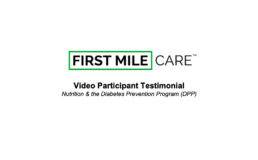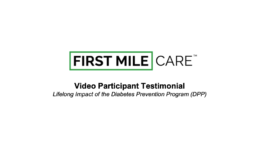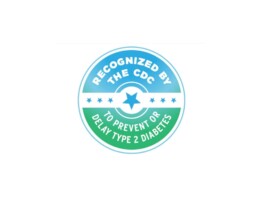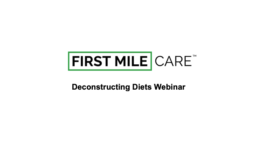Lighter, Smaller, and Healthier — How DPP Has Worked for Me
By Avelino “Al” Cisneros, Jr., First Mile Care DPP Participant
I joined the First Mile Care Diabetes Prevention Program (DPP) nine months ago, at the recommendation of my physician. Since that time, my A1C blood sugar level has dropped. My blood pressure is now consistently in the normal range and I’ve been able to stop taking medication. Oh, yeah, and I’ve lost 30 pounds and two pants sizes. I feel fit and healthy for the first time in years.
The First Mile Care DPP works for me because it’s not a struggle or burden. I watch what I consume, and everything else takes care of itself.
How I got here
A little about me — I just turned 69 years old and live in a small town north of Houston. I retired a few years ago after 40 years with Union Pacific Railroad, having most recently served as vice president of Mexican operations.

Last year I went for my annual checkup. My longtime physician, Dr. Clifford Yut, who practices in The Woodlands, was concerned that my glucose levels in the A1C test kept rising each year. He had prescribed medication, but it wasn’t helping. He warned me that if I didn’t address it, I would develop diabetes. That’s when I first heard about the CDC-proven Diabetes Prevention Program offered by First Mile Care. If he hadn’t recommended the program to me, I would probably have continued as I was. Like many men, I needed some prodding by an expert to take my health seriously.
I had never tried any type of wellness program or diet plan. I had never even heard of “prediabetes” in spite of the fact that my aunts on my father’s side had diabetes and there are cardiac issues in my maternal line. My wife is a retired registered nurse, but even she hadn’t been able to steer my eating and fitness habits into a healthy path, although she was conscientious about cooking with healthy ingredients. She couldn’t get me to change habits I’d picked up during my dozen years of commuting weekly to Mexico, such as social eating and drinking late at night with colleagues and not getting enough exercise. Even after I retired, I still wanted three big meals a day, out of habit, although I was no longer expending the same amount of energy.
Learning to make smarter choices
My First Mile Care DPP coach, Sandra Huskey, has been instrumental in getting me to make smarter choices about what I eat and to shop more wisely. She drives home the point that there is no such thing as “good” food or “bad” food. The First Mile Care program doesn’t require me to give up anything, only to calculate calories and make sure I get enough exercise to offset my caloric intake. I’ve found food journaling to be extremely helpful, and have continued to practice it even after the required period ended. I review my journal on a weekly basis to see where I succeeded and where I succumbed to temptation.
Coach Sandra encourages us all to read labels carefully, track calories in our food journals or apps, and make wise decisions based on whether an item is really worth how long it will take to burn off the calories. I never used to look at food labels or packaging. When my wife asked me to pick up bread and butter at the grocery store, I grabbed the first thing I saw to get out of there as quickly as possible. I never considered basing my choices on sodium and fat and carbohydrate levels.
I’ve also become attuned to where tempting foods and empty calories are placed on shelves. For example, if I go into a convenience store to grab a coffee, there are doughnuts nearby, or candy by the cash register. So instead of giving into sugar cravings and grabbing the things nearest me, I walk a couple of aisles back and find a healthier snack like unsalted nuts or celery sticks.
My coach has taught me to look for substitutions and little tricks so I still get to savor my pleasures, like buying the mini-empanadas at my favorite Argentine restaurant instead of the big ones. I now avoid eating potatoes and rice at the same meal, stay away from sweet yams, and make a point of choosing a smaller piece of meat and removing the fat. If I eat chips, I don’t finish off a big bag. If my grandkids want pizza, I have one slice instead of two — or else cut back on something else and get in some walking to make up for that extra slice.
The hardest thing for me to control has been beer and bread. I still eat bread, but a half-slice of toast instead of a half a loaf of French bread in one sitting. I finally decided to cut out beer altogether, but mainly because I calculated how much I was spending per month with only a bulging waistline to show for it! Now I drink a lot of water with lemon.
Neighborly advice
An advantage of the First Mile Care program is that it promotes a sense of neighborly community. Not only is my coach from my general area north of Houston, so are the other members of my small group. As a result, as we go through our lifestyle transformation together; we have this foundation of common references that puts everyone at ease and automatically makes you feel more comfortable with each other, even if we come from different backgrounds, cultures, and even countries. We reinforce each other’s decisions, provide encouragement to the folks who are struggling, and celebrate overcoming temptations. My classmates have become friends, so I look forward to spending time with them in-person now that COVID-19 restrictions have been lifted.
The local aspect of the group is also really helpful for sharing tips on the best walking trails, what’s in season at the farmer’s market, which grocery store is having a sale or offers specialty products. We help each other overcome our little humps, too. For example, if you’re not from Houston, you might not realize how incredibly debilitating the humidity is, or how vicious the mosquitoes are at dusk. But my coach and classmates knew exactly why I was having trouble exercising in the early evening. They recommended that, as an early riser, I should try walking at dawn. Now I walk a mile — two turns around the retention ponds in my neighborhood — and can be back home in time for breakfast and “Good Morning America.” I make a point of walking whenever I can, instead of sitting, and can work up a real sweat by gardening. I now realize there are so many easy forms of movement that burn calories and “count” towards my fitness goals.
Everybody’s happy
First Mile Care has truly changed my life. My DPP coach has given me the building blocks I need to maintain good health not only while I’m in the program, but for the long term. The program just fits me like a glove, as it reinforces the little healthy choices that my wife spent years trying — unsuccessfully — to impress on me.
My wife is pretty pleased with me now, though, despite the fact that I ignored her advice for years and it took a third party, my doctor, to get me to address my worsening condition. My wife still checks my blood pressure daily, but she has seen the downward trend since I started the DPP. She now admits that she was worried about my health last year, especially when the doctor jacked up my B.P. medication dosage but it still didn’t work.
Not long ago, I asked a tailor to tighten my baggy pants. He refused, saying “You look like a clown!” He could only make them fit by pulling the pockets close together and bunching the material in back. He told me it was time to break down and buy new ones. I still have a couple of months to go before completing the year-long First Mile Care program. I’ve already told my wife to expect to go shopping with me for more new pants and belts!
I went for my annual physical exam recently, and my doctor was elated at my weight loss and lower A1C and blood pressure levels. He said, “If everybody followed the principles of First Mile Care, I’d be out of a job.“
To learn more about how you can benefit from the First Mile Care Diabetes Prevention Program, take the prediabetes risk test and get started today!
First Mile Care Achieves Full CDC Recognition Status for DPP
By Karl Ronn, First Mile Care CEO and Founder
I am delighted to share the news that the Centers for Disease Control has awarded First Mile Care the coveted Certificate of CDC Full Recognition for our Diabetes Prevention Program (DPP). This “full” designation is given only to programs that have successfully delivered “a quality, evidence-based program that meets all of the standards” of the National Diabetes Prevention Program to delay type 2 diabetes. CDC-recognized organizations are able to enroll as Medicare Diabetes Prevention Program (MDPP) suppliers.
The DPP is a year-long, science-based behavior modification program clinically proven to stop the onset of type 2 diabetes by 58%, and 71% in those over age 60. The DPP includes weekly sessions, lifestyle coaching, peer support, and behavior tracking tools.
To achieve CDC Full Recognition, the First Mile Care team had to meet stringent requirements in a number of categories:
- Lifestyle curriculum content
- Staffing and training
- Intervention duration and intensity (frequency of sessions over one year)
- Minimum percentages for session attendance over the year
- Documentation of body weight
- Documentation of physical activity minutes
- Average weight loss across all participants in the year-long cohort of a minimum of 5% of starting body weight
We are very proud that despite the challenges of the COVID-19 pandemic, First Mile Care participants have attained an average weight loss of 6.5% of starting body weight, well above the CDC minimum! While some participants have lost as much as 30 pounds over a year, the program emphasis is on overall health improvements and not weight loss alone.
The value of the neighborhood
First Mile Care takes the burden off physicians and health care systems by functioning as an extension of their practice. We partner with them to recruit and organize patients by practice ZIP codes to develop critical mass for establishing local DPP classes. We also recruit and certify local coaches in DPP and report back to physicians on patient progress.
A First Mile Care distinction is our community focus and emphasis on a shared neighborhood experience among DPP group participants. We help our coaches tailor sessions to reflect local activities, amenities, culture, foods, languages, and lifestyles. The neighborhood aspect also fosters retention by encouraging supportive relationships, peer accountability, and information-sharing of local insights. Participants overcome obstacles and celebrate successes together. Our goal is to counsel participants both one-on-one and in group settings within 10 minutes of their homes and at convenient times, to facilitate participation regardless of busy schedules or transportation challenges.
“I feel it is important for me to participate in a neighborhood group,” said Jeannie Lawson, a DPP participant in The Woodlands, Texas, a Houston suburb. “The more similar I am with the group, the more comfortable I feel. Knowing my classmates are from the same geographic area helps. Because of their support, I feel safe enough to share my successes as well as my failures.”
Our groups have been able to retain their neighborhood focus throughout the COVID-19 pandemic. “Because my coach is part of the local community, she can give us tips and tools that are realistic about nearby walking trails, healthy restaurants, specialty food markets, and fresh vegetable markets,” said Tomas Zapata, another DPP participant in The Woodlands.
As Miram T. Bell, the team lead for the National Diabetes Prevention Program, wrote, “The sustained success of your lifestyle change program makes an invaluable contribution to the prevention of type 2 diabetes, both in your community and nationally.”
Could you be at risk for prediabetes? Take the test and find more information on our Resources site.
Keeping Your Brain Healthy As You Age
By Karalyn Cass, First Mile Care DPP Coach
The goal of the National Diabetes Prevention Program (DPP) is to help participants develop new habits they can sustain in order to lead a healthy lifestyle in the long term and prevent prediabetes. But a healthy lifestyle is not only concerned with physical fitness; it’s also about mental and emotional health. As part of the First Mile Care “Diabetes Prevention in Action” webinar series, I offered some tips on how to keep your most important organ — your brain — healthy as you age.
As part of the natural aging process, you experience gradual changes to your body. Your brain ages just like the rest of your body. It shrinks in size, it slows down in speed, it becomes less adaptable to change. Therefore, it’s critical to stretch your brain as well your heart, legs and other muscles.
Most people will continue to have strong memories as they grow older, and their ability to remember will not decline rapidly or substantially. But almost 40% of us will experience some form of memory loss at some point after age 65. A recent study published in JAMA Network Open emphasizes the importance for women, especially, to flex their brain to keep it in good condition. Women in the study showed faster declines in global cognition as they aged, even though memory decline was about the same as for men.
Typical age-associated memory impairment may include your inability to remember details of a conversation or event that took place over a year ago. Sometimes you might have difficulty finding a word at the tip of your tongue, or remembering the name of an acquaintance. That’s normal. But when your memory loss affects your ability to stick to your normal routine, you’re finding it difficult to learn new things or complete familiar tasks, and people close to you notice changes in your abilities, those could be signs of greater cognitive decline or even dementia that you should discuss with your physician.
The diabetes-dementia link
Researchers in the UK are investigating how people with prediabetes run an elevated risk of cognitive decline. In the study, higher-than-normal blood sugar levels were linked to an increased likelihood of vascular dementia, a common form of non-Alzheimer’s dementia caused by reduced blood flow to the brain. And according to a study report in Diabetes Care, people with diabetes were 60% more likely to develop any form of dementia than people without diabetes.
Knowing that if you are prediabetic, you are at greater risk for cognitive decline, it’s important to do what you can to reverse prediabetes and keep your brain from becoming flabby. Luckily, there are many things you can do to improve your brain health as well as your physical fitness and emotional well-being, which all influence each other.
- Exercise (aerobic, strength training, balance, flexibility)
- Healthy eating (especially brain-healthy foods such as berries, fish, green vegetables, and nuts)
- Social connections
- Reading and writing
- Sleep quality and stress management
- Art, music, and animal therapy
- Learning new things (crafts, skills, languages, etc.)
Training your brain
Crossword and jigsaw puzzles, card games, word and number games, brain teasers, matching games, video and computer games, drawing, and even coloring books can stimulate your mind and sharpen your brain. The important thing is that they involve concentration, analysis and problem solving, and memory.
There are many brain teasers and challenges you can find simply by going on YouTube or otherwise searching the internet. A few good sources — both free and paid subscriptions — can be found on the AARP’s Staying Sharp site, Cleveland Clinic’s Healthy Brains site, Lumosity, and Sharp Brains.
Watch the video below for my full presentation on improving brain health and adding quality years to your life.
To learn more about how you can benefit from the First Mile Care Diabetes Prevention Program, take the prediabetes risk test and get started today!
Deconstructing Popular Diets
By Kathy Gregory, First Mile Care DPP Coach
A core component of the National Diabetes Prevention Program (DPP) is learning to eat well and develop new healthy lifestyle habits to reverse prediabetes. As part of the First Mile Care “Diabetes Prevention in Action” webinar series, I looked at the pros, cons, and commonalities of several popular diets.
It’s important to understand that diet, weight loss and healthy eating are linked, but not interchangeable. People invest a lot of time (and money) in searching for a magic weight loss formula, but diets are definitely not one-size-fits-all. If you fail to stick to the guidelines, you may feel guilty and become discouraged, even though we all have different motivational triggers. What is successful for one person may be really challenging for someone else. When you’re fixated on weight loss, rather than on adding quality ingredients and calories to promote wellness, you’re more likely to develop an unhealthy relationship with food.
Let’s look at five of the most popular diets today.
- Keto Diet — This diet requires detailed food tracking to adhere to recommended percentages. The focus is on healthy fat for about 75% of your daily calories, 20% protein intake, and no more than 5% carbohydrates. Due to the high fat and protein intake, you may feel fuller for longer. However, because it’s very low in fibrous foods such as fruits, vegetables, and whole grains, it can result in nutrient deficiency and constipation.
- Paleo Diet — This diet emulates the dietary pattern of our ancestors by emphasizing fresh foods and avoiding processed foods. It promotes the intake of healthy fats, vitamins, and minerals from fresh foods but excludes legumes, dairy, and grains, so some people may not absorb enough fiber, calcium, or vitamin D.
- Whole30 Diet — An elimination diet that requires you to cut out grains, dairy, legumes, alcohol, and added sugars and sweeteners from your diet for 30 days, mainly to help you identify food sensitivities or allergies. While it does not focus on calorie count, you may miss out on some important nutrients. It can be so restrictive that you may find it difficult to maintain without a medical reason.
- Intermittent Fasting (IMF) Diet — The 16:8 is the most common IMF diet, where you’re encouraged to eat more fruits, vegetables and other health-promoting foods but only during an eight-hour period, while fasting during the other 16 hours. While it eliminates all-day grazing, it is very restrictive and can lead to bingeing during eating windows. Also, as your body adapts to “starvation” periods, it will begin to burn fewer calories as it senses you may not be getting enough nutrients.
- Mediterranean Diet — This follows the food traditions of many Mediterranean countries by focusing on olive oil, vegetables, fruits, nuts and seeds, beans, whole grains, and some dairy products. It is low in saturated fats and fairly easy to follow as it is not particularly restrictive, although it requires the availability of fresh ingredients to prepare meals at home.
Commonalities
These diets all advocate eating fresh, whole foods — meaning, foods that are not processed. Whole foods are fruits, vegetables, lean proteins, dairy — not something you buy in a box or package. (Pro tip: When you go to the grocery store, try to spend the majority of time shopping in the perimeters where you’ll find whole foods, or in farmer’s markets to get what’s in season.)
Another commonality among several of these diets is restriction. Yet that can be their downfall as restriction generally does not work over time because we run out of willpower. The more complicated and restrictive a diet, the harder it becomes to adhere to it over time.
Eating for health
The DPP emphasizes eating for health, not short-term weight loss. But weight loss IS a natural side effect of eating for health; it just takes time to achieve. At First Mile Care, we recommend DPP participants follow these guidelines:
- Eat whole food – fresh vegetables should be about 50% of your plate, lean protein about 25%, and starchy vegetables or whole grains 25%
- Cook at home so you can control ingredients, calorie quality, and portion sizes
- Exercise daily (at least 150 minutes per week)
- Manage your stress load
- Get adequate and quality sleep
- Stay properly hydrated with water and not sugary drinks
Good health results from consistent behaviors. Making lifestyle changes that endure can be a slow process, but a rewarding one that pays big dividends.
Watch the video below for my full presentation on diets, healthy eating, and their link to diabetes prevention.
To learn more about how you can benefit from the First Mile Care Diabetes Prevention Program, take the prediabetes risk test and get started today!
Struggling With Sugar Cravings
By Jenny Fowler, First Mile Care DPP Coach
Feeling in control of your food choices is an important step along the road to healthy living. But when it comes to sugar, many of us struggle with temptation or even addiction despite our best efforts to control the craving.
As a certified holistic nutrition consultant and wellness coach, I help participants in the National Diabetes Prevention Program (DPP) determine strategies to control unhealthy eating habits that can lead to prediabetes. One of the most challenging is sugar consumption. I led a discussion on dealing with sugar cravings as part of the First Mile Care “Diabetes Prevention in Action” webinar series.
It’s important to get a handle on sugar cravings to maintain stable energy throughout your day, to help balance blood sugar, and to aid in weight control. Oftentimes, you feel sugar cravings when your blood sugar is imbalanced. If your blood sugar is too low, your body wants a quick fix to bring the sugar back to a more stable level. You may make poor food choices to satisfy that sugar craving, food choices which can negatively affect your weight.
The main reasons for sugar cravings fall into three buckets:
- Nutrition: Are you getting enough of the three macronutrients each day? The amino acids in protein build the brain chemicals that stop sugar cravings. What about unrefined carbohydrates, your body’s preferred source of fuel? Do you eat the right amount of healthy fat, which helps keep your blood sugar stable?
- Habits: Are you craving sugar because you habitually have something sweet as part of a routine or at a certain time of the day? Are you eating regularly (every 3-5 hours) throughout the day to keep your blood sugar stable?
- Emotions and Location: Are you craving sugar simply because you can see or smell something sweet in physical proximity? Or just know that there are doughnuts in the cupboard and ice cream in the freezer? Or are you under stress, which can cause your blood sugar to peak and crater, throwing your body into a red alert?
When you feel a sugar craving, think about WHY you are experiencing it. It may be because your meal planning doesn’t address the right balance of the three macronutrients. Or you’re in the habit of eating cookies with an afternoon cup of tea. Or you’re experiencing a lot of stress at work.
Once you can figure out your trigger(s) for craving sugar, it’s easier to address those cravings. Instead of just trying to deny your body what it wants, find an alternative activity or substitute routine. In a different webinar, I provided tips on calming activities that can reduce stress and help avoid nervous eating. Oftentimes, if there is not a physical reason for the craving, it will pass if you distract yourself with another activity.
Of course, if there is a physical reason, make sure you have some tasty but healthy snacks available so you don’t reach for the chocolate. Or perhaps you need to eat the three macronutrients more often, more regularly, in smaller amounts, to avoid the blood sugar highs and lows that lead to sugar cravings. The important thing is to give your body regular, healthy fuel to keep your blood sugar fairly balanced and avoid big swings and crashes.
Watch my webinar video below for more ideas on how to gain control of your sugar cravings. It does get easier!
To learn more about how you can benefit from the First Mile Care Diabetes Prevention Program, take the prediabetes risk test and get started today!
Karl Ronn of First Mile Care: “Sleep is also critical to wellness, and something our coaches touch upon in multiple sessions”
Often when we refer to wellness, we assume that we are talking about physical wellbeing. But one can be physically very healthy but still be unwell, emotionally or mentally. What are the steps we can take to cultivate optimal wellness in all areas of our life; to develop Mental, Physical, Emotional, & Spiritual Wellbeing?
As a part of our series about “How We Can Do To Cultivate Our Mental, Physical, Emotional, & Spiritual Wellbeing”, Karl Ronn, founder and CEO of First Mile Care, a Silicon-Valley based preventative chronic care company that develops affordable, scalable, and sustainable solutions to reverse health conditions like prediabetes was interviewed.
Read more on Thrive Global here >
Everyday Health: TIPPI Type 2 Diabetes
First Mile Care Diabetes Prevention (DPP) coaches share their tips for preventing and reversing type 2 diabetes with Everyday Health.
Coach Bibi Ladipo – 1 tip tagged for Emotional Health and Self-care & Wellness and Resources (3 categories)
Coach Jenny Fowler – 2 tips each tagged for Self-care & Wellness
Coach Kathy Gregory – 3 tips tagged for Diet & Nutrition (1) and Blood Sugar Management (2)
Coach Sandra Huskey – 1 tip tagged for Fitness
Coach Shavon LeBlanc – 2 tips tagged for Self-care & Wellness (1) and Fitness (2)
Read all the tips on TIPPI >
How Health2047 nurtures innovation on medicine’s biggest challenges
To date, Health2047 has helped launch nine new companies. One example is First Mile Care, a company that has rethought chronic care management. The Centers for Disease Control and Prevention’s (CDC) Diabetes Prevention Program has been shown to reduce the incidence of type 2 diabetes by 58%. But expanding on the idea to reach more people has proved a challenge.
Learn more from the American Medical Association >
Having Fun With Hydration — It’s More Than Just Water
By Sandra Huskey, First Mile Care DPP Coach
When you hear “hydration” you immediately think “water,” right? Your body is about 60% to 70% water. Water aids digestion, keeps your blood moving, helps your kidneys and bowels work, provides saliva, and regulates body temperature, among other critical functions. It energizes your muscles and joints and reduces fine lines in your face. It wards away headaches and fatigue and keeps you alert. It also helps you to control calorie intake and your weight, because water helps to fill you up.
But hydration goes beyond just drinking water. If you eat fruits and vegetables that are full of water, they make you feel fuller for longer. As part of the ongoing series of “Diabetes Prevention in Action” webinars offered by First Mile Care, I shared my tips for making hydration fun and looked at how to jazz up your water intake and make healthy smoothies.
In the clinically-proven National Diabetes Prevention Program (DPP), coaches emphasize that you need to be mindful of everything that goes into your body — and that includes all liquids. First Mile Care DPP coaches recommend that you keep a food journal to track your intake. We teach DPP participants to read food and nutrition labels carefully as the ingredients of what you eat and drink go towards your calorie, carbohydrate, sugar, fiber and other nutrient counts.
Water, water, everywhere
How much water should you drink? That varies based on your body size and how much you’re exercising and perspiring. In the summer months in Texas where I live, you’re going to want to increase your hydration to a bare minimum of 64 ounces if you’re exercising, but you could aim for 80 ounces. My tip is to keep full glasses of water around the house, or for some folks, it’s drinking from big containers where they can easily measure their intake.
The important thing about water is to know your sources and look at the labels, as all water is not created equal. Here are a few things to keep in mind.
- Tap water. Check what minerals your municipality adds to it.
- Mineral water. It varies by the source, and naturally has different nutrients in it.
- Bottled water. Some may come from a particular spring, but some come from a water municipality, and even “purified” water may have calcium, chloride, magnesium salts and other additives.
- Sparkling water. The added carbon dioxide gives it the bubbles. Most sparkling waters like Lacroix are flavored, so check the label for the additives.
- Club soda or seltzer water. The bartender’s favorite, probably because it has a bit of saltiness, although it’s basically just like sparkling water.
- Tonic water. Consider it a soda drink and not a water, as it has a lot of added sugar and sodium as well as quinine, which can increase heart rhythm.
- Sports drinks. Check the additives, as Gatorade, for example, has a lot of added sugar.
You’ll be more inclined to increase your water consumption if it has a pleasant taste. Luckily, it’s easier to turn boring water into a flavored beverage than for Cinderella to turn into a princess. Consider infusing a jug or glass of water with herbs like basil or mint, or lemon or lime quarters, or cucumber slices.
Satisfying smoothies
You can jazz up your water, but sometimes you want something a little more satisfying. For example, I drink smoothies as a snack or to replace electrolytes and lost fluids after a run or other physical activity. And it’s easy to make your own delicious, healthy smoothies! Here are a few of my basic ingredients.
- Base: plain yogurt, coconut water, low-fat milk, almond milk, oat milk, soy milk
- Protein: peanut butter, almond butter, cashew butter, pistachio butter
- Fiber: flaxseed, flax meal, chia seed or even veggies such as spinach
- Consistency: banana (it has sugar), or a healthy fat like avocado or sweet potato (but remember they are still fats!)
- Flavor: cinnamon, unsweetened cocoa, ginger, turmeric, vanilla
- Sweetener: go natural with honey or fruit like blueberries, which are lower in sugar than dates
If you’re just starting out with homemade smoothies, you might want to limit yourself to only a few key ingredients. For example, yogurt, coconut water, peanut butter, and one flavoring.
The good thing about homemade smoothies versus purchased ones is that every ingredient is under your control. Anything you put in it will go towards your nutritional and calorie counts, so always check the labels for the amounts of sugar, sodium, protein and fiber. For example, coconut water has sugar, but it’s natural sugar and the calories are lower than in other drinks. Almond Breeze milk is unsweetened so has no sugar. Yogurt with fruit is higher in sugar and calories, which is why I recommend plain yogurt so you can add your own flavors and better track your nutritional intake.
Watch my webinar video below to learn more of my tips for making hydration fun!
To learn more about how you can benefit from the First Mile Care Diabetes Prevention Program, take the prediabetes risk test and get started today!
28 Nutritionists & Health Enthusiasts Reveal the #1 Healthiest Food in the World (and Why)
First Mile Care DPP Coach Jenny Fowler shares her opinion on the #1 healthiest food.
Read more on Incredible Edibles >



















